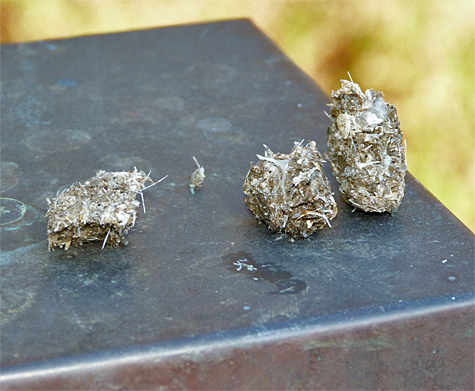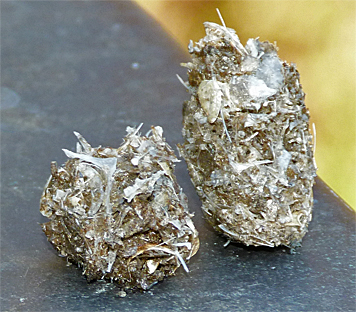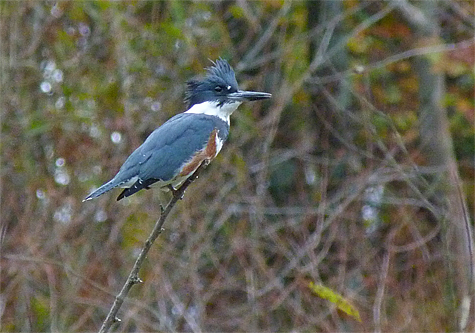Back from the weekend and on my first walk around the Outdoor Exhibit Loop I noticed three gray masses of debris on one of the copper-topped posts of the boardwalk in Explore the Wild. It was obviously a pellet.

What’s a pellet? Basically it’s a regurgitated mass of animal parts, bones, fur, or feathers which can not be digested by whatever it was that ate the animal, typically a hawk, owl, or perhaps a heron. These birds swallow small prey whole. The prey moves down the esophagus, into the proventriculus (a sort of pre-stomach) and then into the gizzard. It’s here that the meal is separated into edible and non-edible parts. The meat goes down through the rest of the digestive tract and the fur, feathers, scales (in the case of a fish), and bones remain in the gizzard.
The undigestible material is formed into a round or oval shaped pellet and pushed back up into the proventriculus where it sits for several, to as many as twenty, hours. The pellet must be regurgitated in order for the hawk, owl or heron to eat another victim. And, sure enough, since it at least partially blocks the only way into the stomach, out it comes when it’s time to eat again, plop onto the ground, or railing post in this case.
That said, most of you probably already know what a pellet is. In recent years, most elementary and high school science classes across the country have presented their students with owl pellets to dissect. It’s fun to break open the pellet and see what’s inside, usually some mouse, rat, or perhaps vole parts.

The pellet I was staring at had fish bones throughout. My first thought was that our Great Blue Heron had deposited the pellet on the post. However, if the heron had been standing on the post, one foot would have nearly, if not completely, covered the top of the post leaving no room for it to plop down the pellet. It must have been a smaller bird that left this pellet for me to wonder at.
What’s smaller than a heron and eats fish? Mergansers and kingfishers eat fish. I can’t imagine a merganser sitting on the railing of the boardwalk so it must have been a kingfisher that tossed up the pellet. It looked a tad large to have come from a kingfisher but after mulling it over a bit, and doing some research, I decided it had to be a kingfisher’s pellet.

The pellet was about 2 inches long and about 3/8 to 1/2 inch in diameter. Since there was no fur to bind the pellet, after drying out it separated into the three pieces that I found on the post.
Isn’t nature wonderful.
Dont forget to mention that certain birds can digest the bone material so you may not find any bones at all, just fur 🙁
That’s right Jill, there are indeed birds that can digest the bone. Certain gulls and seabirds can digest fish bones and I’m sure there are others.
There are about 10,000 species of bird in the world so you can imagine how many variations there are when it comes to digestion.
The Lammergeier, or Bearded Vulture, an Old World species, eats almost exclusively bone. About 90% of its diet is bone!
On the other side of the equation, a species of songbird here in the states eats, among other things, desert mistletoe berries. The bird is an all black or gray (male/female) bird of the southwest. The seeds and pulp of the mistletoe berries the bird eats quickly passes through the digestive tract. The skin of the berries are removed in the gizzard and temporarily stored there while the seeds and pulp continue to move through the system. The skins are later released in little “packets” for further digestion. This aids in the efficiency of the processing of the seeds and pulp which is important for the bird’s energy needs, and in the propagation of the mistletoe.
The seeds, having passed through the digestive tract and deposited, hopefully, on a branch of a host tree through defecation, may sprout into a new plant. The bird has just planted a mistletoe which will produce more berries for it to eat.
There’s something for everyone.